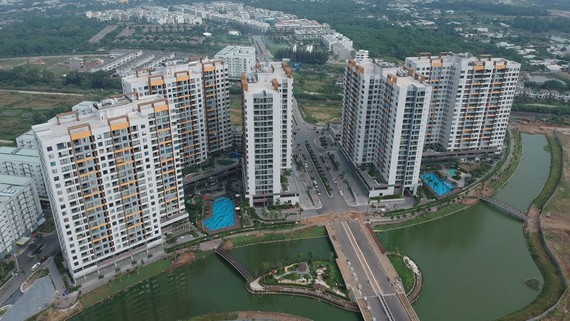
Overall, credit in the first three quarters of this year was low, but real estate credit still posted a fairly good growth. In comparison with the real estate credit outstanding balance of VND521.82 trillion in 2019, which accounted for 6.37 percent of the industry's credit, real estate credit outstanding balance reached more than VND526.39 trillion in the first quarter of this year, nearly VND580.17 billion in the second quarter, and VND606.25 trillion by August this year.
However, as the total outstanding loans of the whole industry also increased from VND8.19 quadrillion in 2019 to VND8.3 quadrillion in the first quarter of this year, VND8.49 quadrillion in the second quarter, and VND8.59 quadrillion by August, the real estate credit growth basically remains within the safe limits at 6.3-7 percent.
A recent report by the Ho Chi Minh City Real Estate Association (HoREA) also shows that the total credit outstanding balance in Ho Chi Minh City in the first ten months of this year reached about VND2.42 quadrillion, an increase of 5.5 percent compared to the end of 2019. Of which, the real estate credit outstanding balance was about VND293.75 trillion, up by 5.9 percent compared to the end of last year. Non-performing loans of real estate enterprises accounted for 2.7 percent of total real estate loans. The HoREA also assessed that real estate credit outstanding balance and bad debts were still within the safe threshold. However, there is a possibility that some real estate credit loans, which are investments in real estate bonds of credit institutions and individuals, might turn into bad debts. Besides, consumer credit outstanding balance, especially for some home repair and home construction loans but having switched to real estate trading, also has many risks. This accounted for 1.7 percent of the total consumer credit outstanding balance, so it is essential to have an appropriate mechanism for control and management.
Assessing the real estate credit, Dr. Can Van Luc, Chief Economist of BIDV, said that the bank credit channel for real estate loans had still posted growth in the past three years. If fully and accurately calculated, this figure is at about 7-8 percent per year, still lower than the credit growth rate of the whole industry at 13-14 percent.
‘Real estate credit is still increasing, which means that the market is not frozen, but there is a shift in investment flows towards a healthier direction,’ he said.
According to many experts, besides the main source of capital for the real estate market, which is bank credit, this market has been attracting other sources of capital, such as personal investment capital, capital from stock and bond issuances of listed companies, and FDI capital.
In fact, over the past time, when credit capital for real estate was tightened at banks to limit risks, the bond market of real estate enterprises was very active. Statistics of securities companies show that in the first nine months of this year, bonds of real estate enterprises continued to lead the issuance proportion. Nearly 90 real estate companies issued nearly VND138 trillion worth of bonds, accounting for 40.3 percent of the total bonds of the corporate bond market.
As for FDI flow, Dr. Can Van Luc said that real estate is always one of the three fields that attract the most FDI in Vietnam (the other two fields are industrial processing and manufacturing and electricity generation). Statistics on the website of the Department of Foreign Investment under the Ministry of Planning and Investment or the General Statistics Office of Vietnam show that although the real estate market suffered double impact by the second wave of Covid-19, the registered FDI capital into the real estate field in the third quarter of this year soared by up to 400 percent compared to the second quarter. By the end of the first nine months of this year, FDI flow into real estate reached US$3.2 billion, accounting for nearly 15 percent of the total newly-registered FDI capital. This is a good signal for the supplement of an important source of capital for investment in the real estate sector in particular and an important contribution to the investment in socio-economic development in Vietnam in general.
























